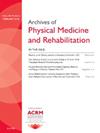“HIST at HOME”: Care Partner–Assisted High-Intensity Stepping Training at Home After Stroke
IF 3.6
2区 医学
Q1 REHABILITATION
Archives of physical medicine and rehabilitation
Pub Date : 2025-04-01
DOI:10.1016/j.apmr.2025.01.062
引用次数: 0
Abstract
Objectives
To investigate the feasibility of patients participating in a care partner–assisted high-intensity stepping (HIST) program in the home after discharge from inpatient rehabilitation (IR) and describe factors that may influence successful adherence.
Design
Participants with stroke who successfully performed HIST at 60%-85% of their heart rate reserve (HRR) or rate of perceived exertion (RPE) of 15-17 for at least 24 minutes, 5 days per week in IR were included. The participants had a care partner who was able to monitor their heart rate or RPE at home and demonstrated the ability to safely assist in HIST in IR. The patient and care partner underwent hands-on training sessions for implementing the program while in IR. Patients and their care partner were given written instructions and a tracking calendar. The participants were asked to track exercise intensity and number of minutes exercised per day at home. Follow-up emails were sent to participants to retrieve the calendar 1-month post DC.
Setting
Supervised physical therapy in IR and care partner assisted exercise at home.
Participants
Preliminary results include N=3 persons after acute stroke in IR, discharging to home with care partner support.
Interventions
Care partners and participants underwent hands-on training for administration of the home-based program before DC home. “HIST at HOME” consists of participants engaging in walking training at 60%-85% of HRR or RPE of 15-17, for at least 24 minutes, 5 days per week with supervision of trained care partner.
Main Outcome Measures
Number of minutes participants walked at the recommended target intensity, number of days exercised, and reports of adverse reactions to the program were tracked.
Results
All patients reported adherence to the recommended program for 1 month after DC. All patients reached the target intensity during walking training at least 5 days per week with supervision of a care partner. No adverse responses were noted.
Conclusions
All patients demonstrated adherence to “HIST at home” with the assistance of a care partner without adverse reactions. Factors including having care partner support, a therapist providing training, and having a 1-month follow-up may have a positive influence on adherence.
Disclosures
none.
“HIST在家”:中风后护理伙伴协助的高强度步进训练
目的探讨住院康复(IR)患者出院后在家中参与护理伙伴辅助的高强度步进(HIST)计划的可行性,并描述可能影响成功依从性的因素。设计纳入以60%-85%的心率储备(HRR)或15-17的感知运动率(RPE)成功进行HIST的中风患者,每周5天,至少24分钟。参与者有一个护理伙伴,能够在家中监测他们的心率或RPE,并表现出在IR中安全协助HIST的能力。患者和护理伙伴在IR期间接受了实施该计划的实际培训课程。病人和他们的护理伙伴得到了书面说明和跟踪日历。参与者被要求记录每天在家锻炼的强度和分钟数。后续的电子邮件发送给参与者,以检索1个月后DC的日历。设置IR的监督物理治疗和护理伙伴在家辅助锻炼。初步结果包括N=3例急性脑卒中患者,在护理伙伴支持下出院回家。在DC回家之前,interonscare的合作伙伴和参与者接受了家庭项目管理的实践培训。“HIST在家”包括参与者以60%-85%的HRR或15-17的RPE进行步行训练,每周5天,至少24分钟,由训练有素的护理伙伴监督。主要结果测量参与者在推荐的目标强度下步行的分钟数、锻炼的天数以及对该计划的不良反应报告进行了跟踪。结果所有患者在DC后1个月内均遵守推荐方案。在护理伙伴的监督下,所有患者在每周至少5天的步行训练中达到目标强度。未发现不良反应。结论:所有患者均在护理伙伴的协助下坚持“在家HIST”治疗,无不良反应。包括护理伙伴的支持、提供培训的治疗师以及1个月的随访等因素都可能对依从性产生积极影响。
本文章由计算机程序翻译,如有差异,请以英文原文为准。
求助全文
约1分钟内获得全文
求助全文
来源期刊
CiteScore
6.20
自引率
4.70%
发文量
495
审稿时长
38 days
期刊介绍:
The Archives of Physical Medicine and Rehabilitation publishes original, peer-reviewed research and clinical reports on important trends and developments in physical medicine and rehabilitation and related fields. This international journal brings researchers and clinicians authoritative information on the therapeutic utilization of physical, behavioral and pharmaceutical agents in providing comprehensive care for individuals with chronic illness and disabilities.
Archives began publication in 1920, publishes monthly, and is the official journal of the American Congress of Rehabilitation Medicine. Its papers are cited more often than any other rehabilitation journal.

 求助内容:
求助内容: 应助结果提醒方式:
应助结果提醒方式:


